Prediction of the Hot Compressive Deformation Behavior for Superalloy Nimonic 80A by BP-ANN Model
Abstract
:1. Introduction
2. Materials and Experimental Procedure
3. Flow Behavior Characteristics of Superalloy Nimonic 80A
4. Development of Constitutive Relationship for Superalloy Nimonic 80A
4.1. BP-ANN Model
4.2. Arrhenius-Type Constitutive Model
5. Prediction Capability Comparison between the BP-ANN Model and Arrhenius Type Constitutive Equation
6. Prediction Potentiality of BP-ANN Model
7. Conclusions
- (1)
- A BP-ANN model taking the deformation temperature (T), strain rate () and strain () as input variables and the true stress () as output variable was constructed for the compression flow behaviors of superalloy, nimonic 80A, which presents desired precision and reliability.
- (2)
- A strain-dependent Arrhenius-type model is developed to predict the flow behavior of superalloy nimonic 80A under the specific deformation conditions. A sixth order polynomial is adopted to reveal the relationships between variable coefficients (including activation energy , material constants , , and ) and strain with good correlations.
- (3)
- A series of statistical indexes, involving the relative error (δ), mean value (), standard deviation (), correlation coefficient (R) and average absolute relative error (ARRE), were introduced to contrast the prediction accuracy between the improved Arrhenius type constitutive equation and BP-ANN model. The mean value () and standard deviation () of the improved Arrhenius-type model are 3.0012% and 2.0533%, respectively, while their values of the BP-ANN model are 0.0714% and 0.2564%, respectively. Meanwhile, the correlation coefficient (R) and average absolute relative error (ARRE) for the improved Arrhenius-type model are 0.9899 and 3.06%, while their values for the BP-ANN model are 0.9998 and 1.20%, which indicate that the BP-ANN model has a good generalization capability.
- (4)
- The true stress data within the temperature range of 950–1250 °C, the strain rate range of 0.01–10 s−1, and the strain range of 0.1–0.9 were predicted densely. According to these abundant data, a 3D continuous interaction space was constructed by interpolation and surface fitting methods. It significantly contributes to all the research requesting abundant and accurate stress-strain data of superalloy nimonic 80A.
Acknowledgments
Author Contributions
Conflicts of Interest
References
- Kim, D.K.; Kim, D.Y.; Ryu, S.H.; Kim, D.J. Application of Nimonic 80A to the hot forging of an exhaust valve head. J. Mater. Process. Technol. 2001, 113, 148–152. [Google Scholar] [CrossRef]
- Zhu, Y.; Zhimin, Y.; Jiangpin, X. Microstructural mapping in closed die forging process of superalloy Nimonic 80A valve head. J. Alloys Compd. 2011, 509, 6106–6112. [Google Scholar] [CrossRef]
- Tian, B.; Zickler, G.A.; Lind, C.; Paris, O. Local microstructure and its influence on precipitation behavior in hot deformed Nimonic 80A. Acta Mater. 2003, 51, 4149–4160. [Google Scholar] [CrossRef]
- Quan, G.-Z.; Mao, A.; Luo, G.-C.; Liang, J.-T.; Wu, D.-S.; Zhou, J. Constitutive modeling for the dynamic recrystallization kinetics of as-extruded 3Cr20Ni10W2 heat-resistant alloy based on stress-strain data. Mater. Des. 2013, 52, 98–107. [Google Scholar] [CrossRef]
- Quan, G.-Z.; Liang, J.-T.; Liu, Y.-Y.; Luo, G.-C.; Shi, Y.; Zhou, J. Identification of optimal deforming parameters from a large range of strain, strain rate and temperature for 3Cr20Ni10W2 heat-resistant alloy. Mater. Des. 2013, 52, 593–601. [Google Scholar] [CrossRef]
- Quan, G.-Z.; Lv, W.-Q.; Mao, Y.-P.; Zhang, Y.-W.; Zhou, J. Prediction of flow stress in a wide temperature range involving phase transformation for as-cast Ti–6Al–2Zr–1Mo–1V alloy by artificial neural network. Mater. Des. 2013, 50, 51–61. [Google Scholar] [CrossRef]
- Lin, Y.C.; Chen, X.-M. A critical review of experimental results and constitutive descriptions for metals and alloys in hot working. Mater. Des. 2011, 32, 1733–1759. [Google Scholar] [CrossRef]
- Huang, Y.-C.; Lin, Y.C.; Deng, J.; Liu, G.; Chen, M.-S. Hot tensile deformation behaviors and constitutive model of 42CrMo steel. Mater. Des. 2014, 53, 349–356. [Google Scholar] [CrossRef]
- Lin, Y.-C.; Chen, M.-S.; Zhang, J. Modeling of flow stress of 42CrMo steel under hot compression. Mater. Sci. Eng. A 2009, 499, 88–92. [Google Scholar] [CrossRef]
- Ji, G.; Li, F.; Li, Q.; Li, H.; Li, Z. A comparative study on Arrhenius-type constitutive model and artificial neural network model to predict high-temperature deformation behaviour in Aermet100 steel. Mater. Sci. Eng. A 2011, 528, 4774–4782. [Google Scholar] [CrossRef]
- Peng, W.; Zeng, W.; Wang, Q.; Yu, H. Comparative study on constitutive relationship of As-cast Ti60 titanium alloy during hot deformation based on Arrhenius-type and artificial neural network models. Mater. Des. 2013, 51, 95–104. [Google Scholar] [CrossRef]
- Wu, H.; Wen, S.P.; Huang, H.; Wu, X.L.; Gao, K.Y.; Wang, W.; Nie, Z.R. Hot deformation behavior and constitutive equation of a new type Al–Zn–Mg–Er–Zr alloy during isothermal compression. Mater. Sci. Eng. A 2016, 651, 415–424. [Google Scholar] [CrossRef]
- Ji, G.; Li, F.; Li, Q.; Li, H.; Li, Z. Prediction of the hot deformation behavior for Aermet100 steel using an artificial neural network. Comput. Mater. Sci. 2010, 48, 626–632. [Google Scholar] [CrossRef]
- Sabokpa, O.; Zarei-Hanzaki, A.; Abedi, H.R.; Haghdadi, N. Artificial neural network modeling to predict the high temperature flow behavior of an AZ81 magnesium alloy. Mater. Des. 2012, 39, 390–396. [Google Scholar] [CrossRef]
- Haghdadi, N.; Zarei-Hanzaki, A.; Khalesian, A.R.; Abedi, H.R. Artificial neural network modeling to predict the hot deformation behavior of an A356 aluminum alloy. Mater. Des. 2013, 49, 386–391. [Google Scholar] [CrossRef]
- Lu, Z.; Pan, Q.; Liu, X.; Qin, Y.; He, Y.; Cao, S. Artificial neural network prediction to the hot compressive deformation behavior of Al–Cu–Mg–Ag heat-resistant aluminum alloy. Mech. Res. Commun. 2011, 38, 192–197. [Google Scholar] [CrossRef]
- Xiao, X.; Liu, G.Q.; Hu, B.F.; Zheng, X.; Wang, L.N.; Chen, S.J.; Ullah, A. A comparative study on Arrhenius-type constitutive equations and artificial neural network model to predict high-temperature deformation behaviour in 12Cr3WV steel. Comput. Mater. Sci. 2012, 62, 227–234. [Google Scholar] [CrossRef]
- Han, Y.; Qiao, G.; Sun, J.; Zou, D. A comparative study on constitutive relationship of As-cast 904L austenitic stainless steel during hot deformation based on Arrhenius-type and artificial neural network models. Comput. Mater. Sci. 2013, 67, 93–103. [Google Scholar] [CrossRef]
- Li, H.-Y.; Wang, X.-F.; Wei, D.-D.; Hu, J.-D.; Li, Y.-H. A comparative study on modified Zerilli-Armstrong, Arrhenius-type and artificial neural network models to predict high-temperature deformation behavior in T24 steel. Mater. Sci. Eng. A 2012, 536, 216–222. [Google Scholar] [CrossRef]
- Gupta, A.K.; Singh, S.K.; Reddy, S.; Hariharan, G. Prediction of flow stress in dynamic strain aging regime of austenitic stainless steel 316 using artificial neural network. Mater. Des. 2012, 35, 589–595. [Google Scholar] [CrossRef]
- Bahrami, A.; Mousavi-Anijdan, S.H.; Madaah-Hosseini, H.R.; Shafyei, A.; Narimani, R. Effective parameters modeling in compression of an austenitic stainless steel using artificial neural network. Comput. Mater. Sci. 2005, 34, 335–341. [Google Scholar] [CrossRef]
- Zhu, Y.; Zeng, W.; Sun, Y.; Feng, F.; Zhou, Y. Artificial neural network approach to predict the flow stress in the isothermal compression of As-cast TC21 titanium alloy. Comput. Mater. Sci. 2011, 50, 1785–1790. [Google Scholar] [CrossRef]
- Serajzadeh, S. Prediction of temperature distribution and required energy in hot forging process by coupling neural networks and finite element analysis. Mater. Lett. 2007, 61, 3296–3300. [Google Scholar] [CrossRef]
- Phaniraj, M.P.; Lahiri, A.K. The applicability of neural network model to predict flow stress for carbon steels. J. Mater. Process. Technol. 2003, 141, 219–227. [Google Scholar] [CrossRef]
- Srinivasa, N.; Prasad, Y.V.R.K. Hot working characteristics of nimonic 75, 80A and 90 superalloys: A comparison using processing maps. J. Mater. Process. Technol. 1995, 51, 171–192. [Google Scholar] [CrossRef]
- Sheikh, H.; Serajzadeh, S. Estimation of flow stress behavior of AA5083 using artificial neural networks with regard to dynamic strain ageing effect. J. Mater. Process. Technol. 2008, 196, 115–119. [Google Scholar] [CrossRef]
- Sellars, C.M.; Mctegart, W.J. On the mechanism of hot deformation. Acta Metall. 1966, 14, 1136–1138. [Google Scholar] [CrossRef]
- Zener, C.; Hollomon, J.H. Effect of strain rate upon plastic flow of steel. J. Appl. Phys. 1944, 15, 22–32. [Google Scholar] [CrossRef]
- Liu, Y.; Yao, Z.; Ning, Y.; Nan, Y.; Guo, H.; Qin, C.; Shi, Z. The flow behavior and constitutive equation in isothermal compression of FGH4096-GH4133B dual alloy. Mater. Des. 2014, 63, 829–837. [Google Scholar] [CrossRef]
- Samantaray, D.; Mandal, S.; Bhaduri, A.K. A comparative study on Johnson Cook, modified Zerilli-Armstrong and Arrhenius-type constitutive models to predict elevated temperature flow behaviour in modified 9Cr–1Mo steel. Comput. Mater. Sci. 2009, 47, 568–576. [Google Scholar] [CrossRef]
- Cai, J.; Wang, K.; Zhai, P.; Li, F.; Yang, J. A modified Johnson-Cook constitutive equation to predict hot deformation behavior of Ti–6Al–4V alloy. J. Mater. Eng. Perform. 2014, 24, 32–44. [Google Scholar] [CrossRef]
- Wang, W.-T.; Guo, X.-Z.; Huang, B.; Tao, J.; Li, H.-G.; Pei, W.-J. The flow behaviors of clam steel at high temperature. Mater. Sci. Eng. A 2014, 599, 134–140. [Google Scholar] [CrossRef]
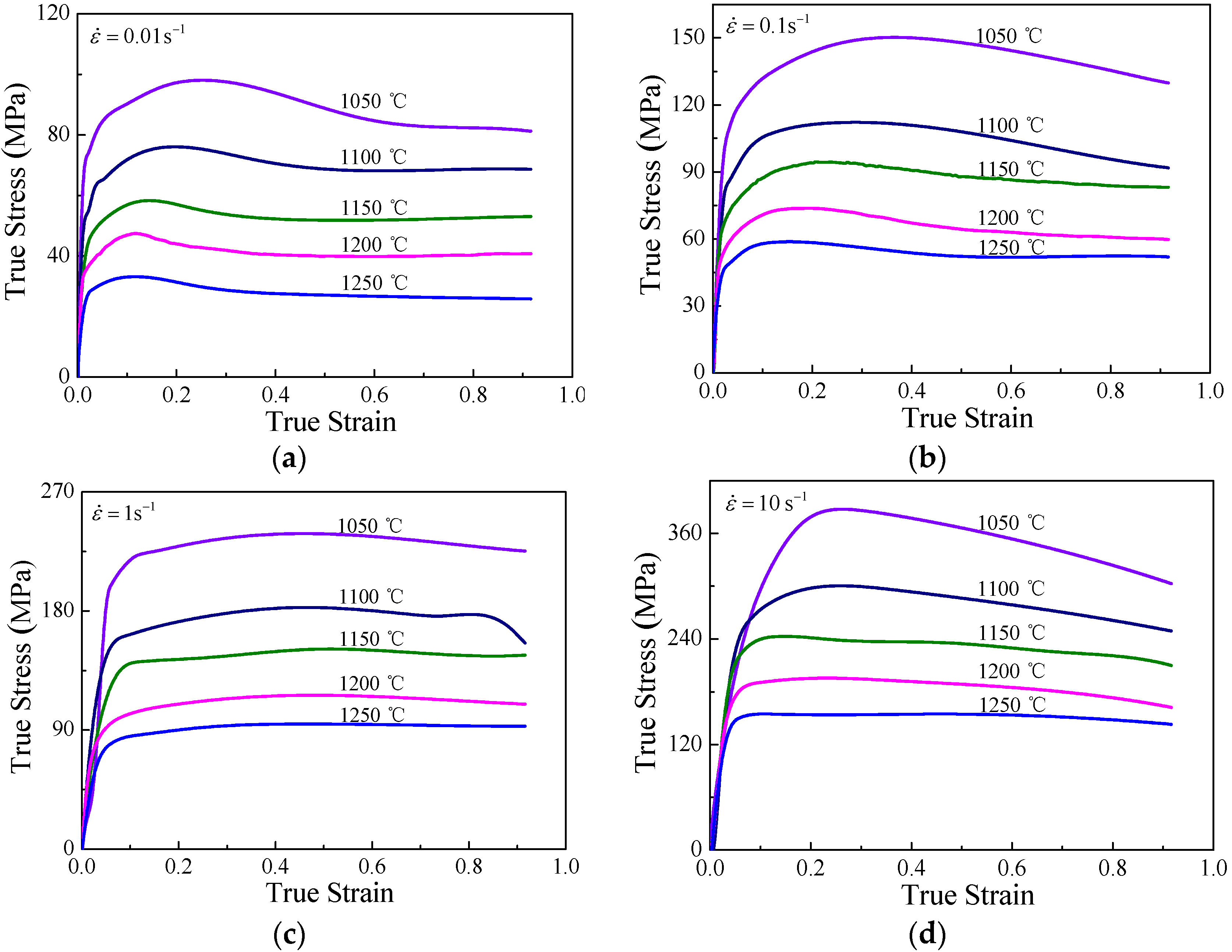
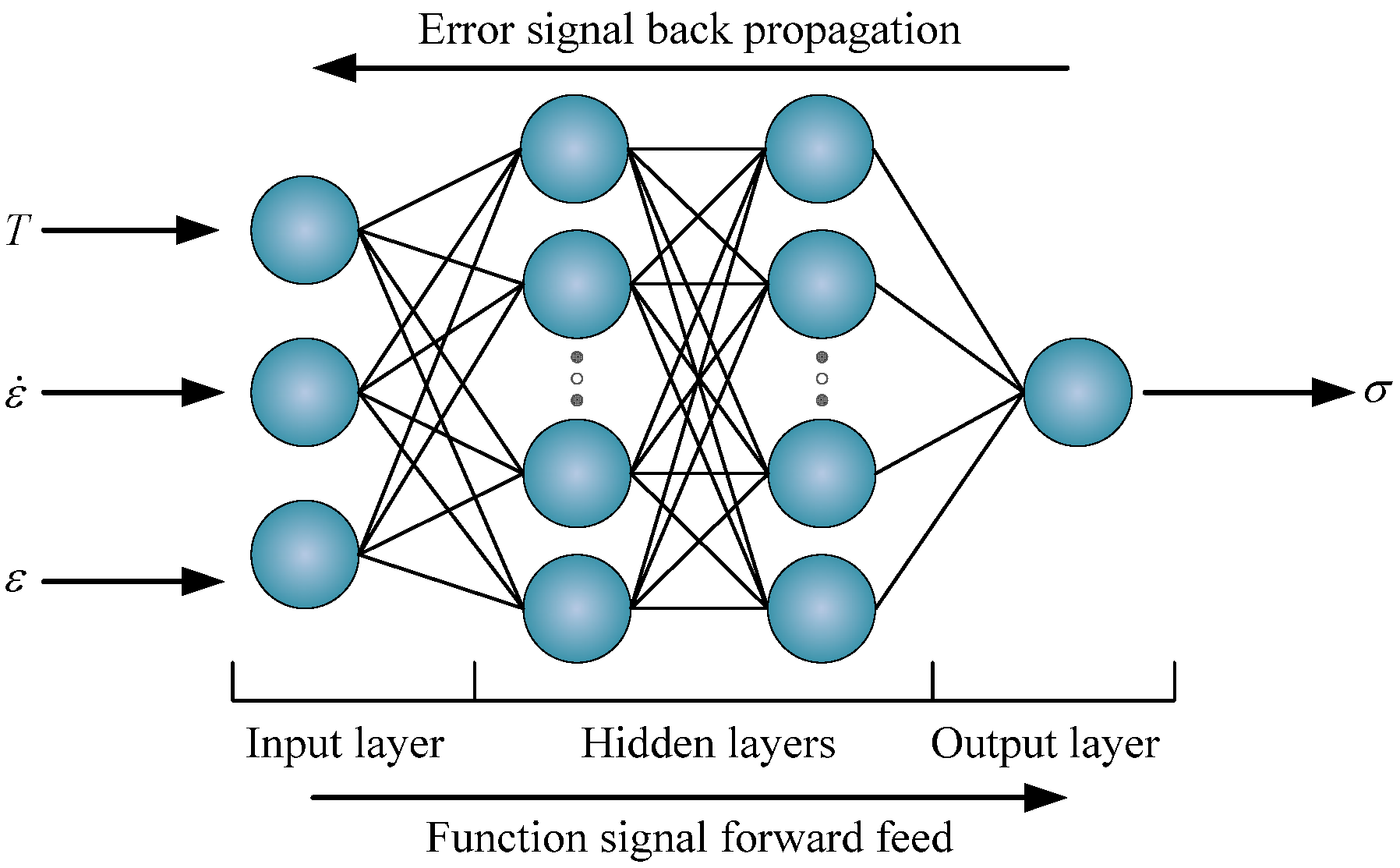
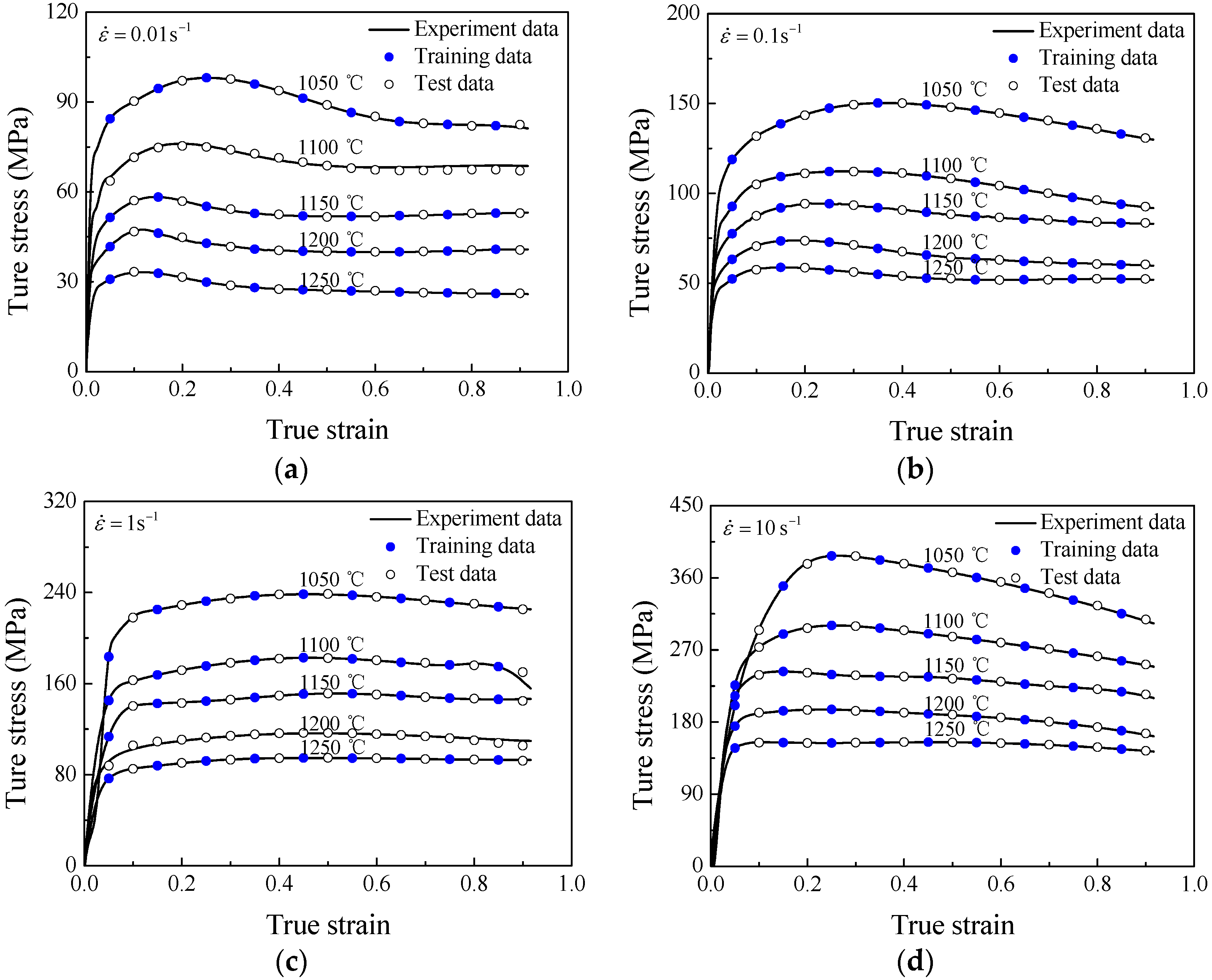
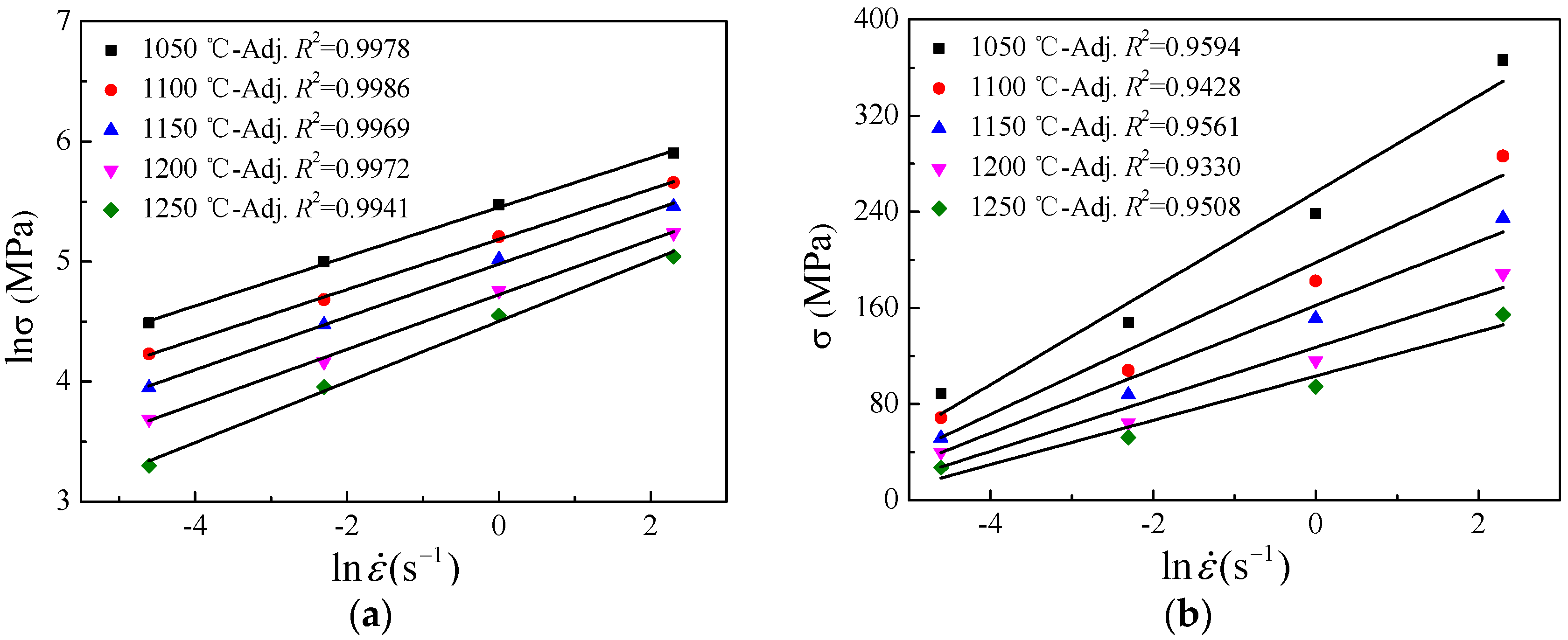

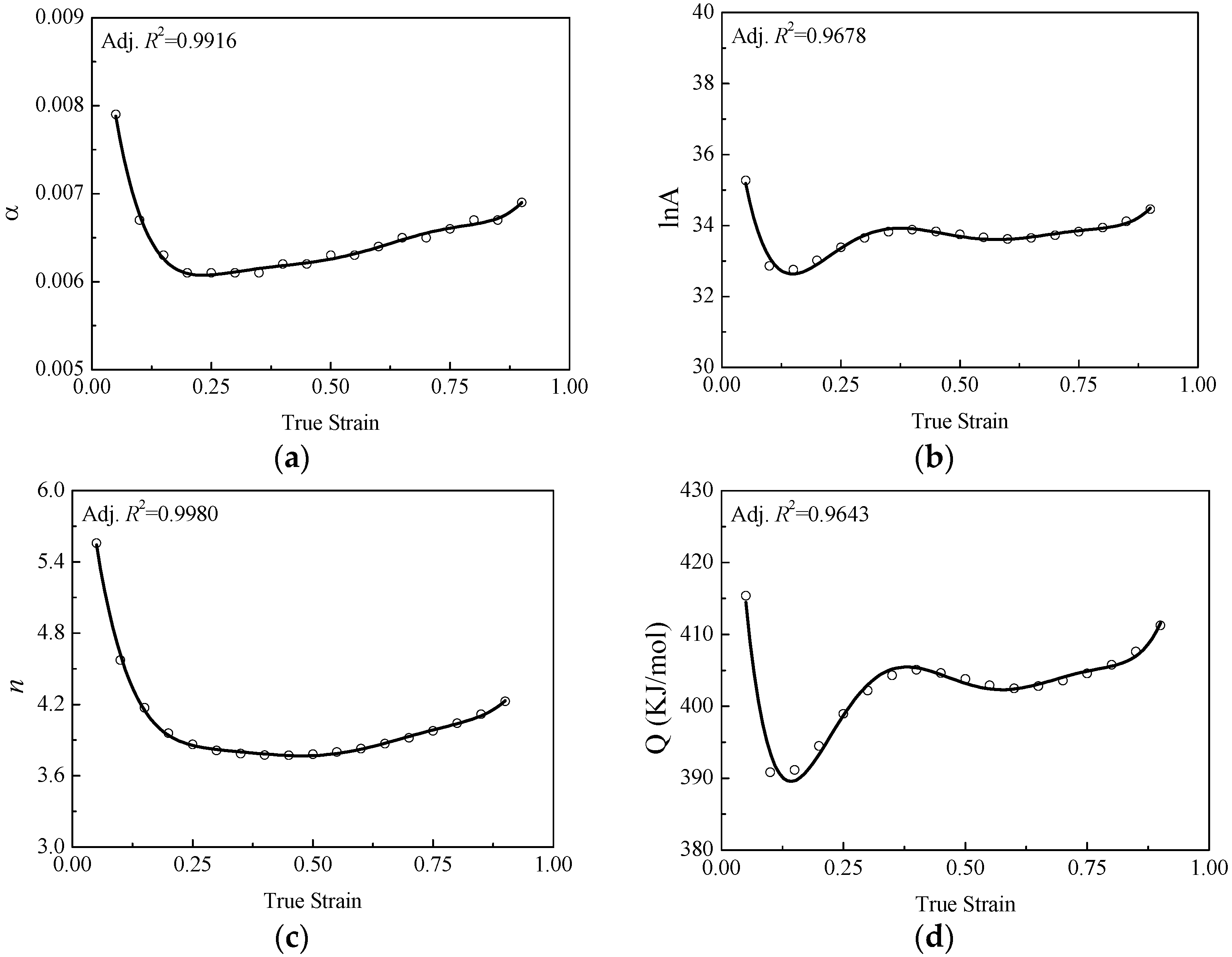
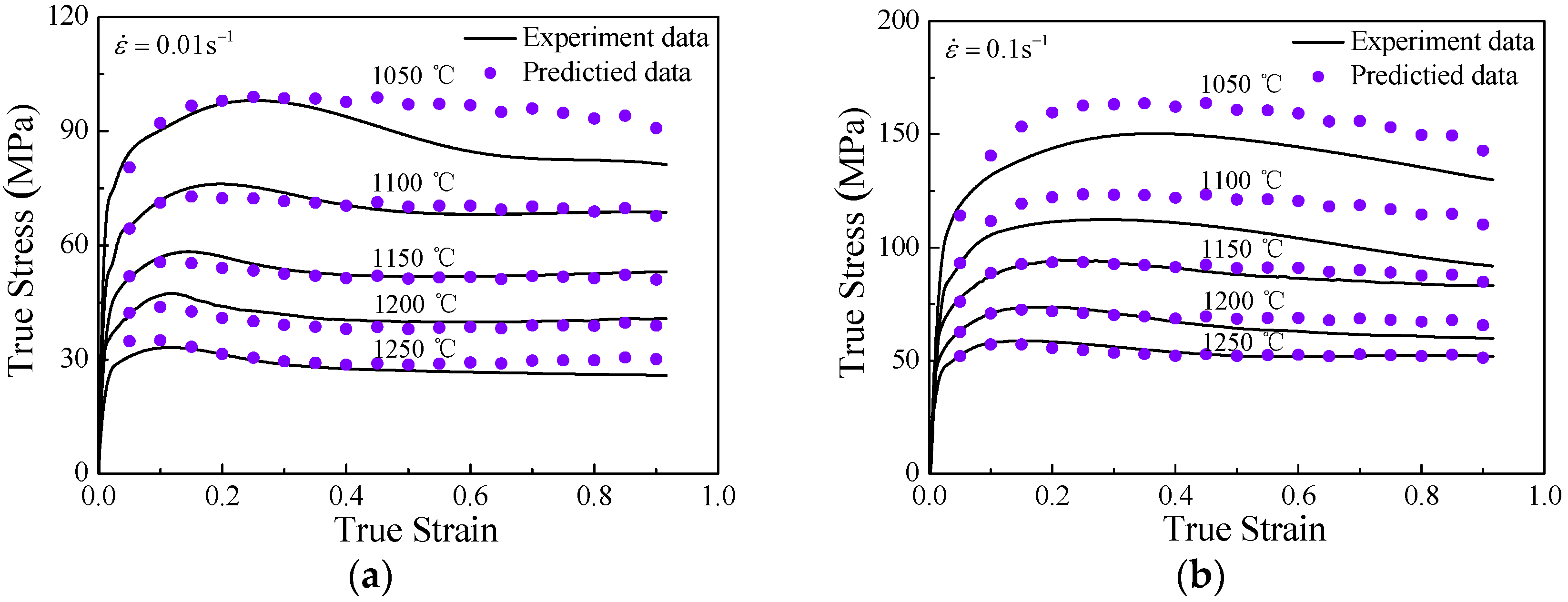
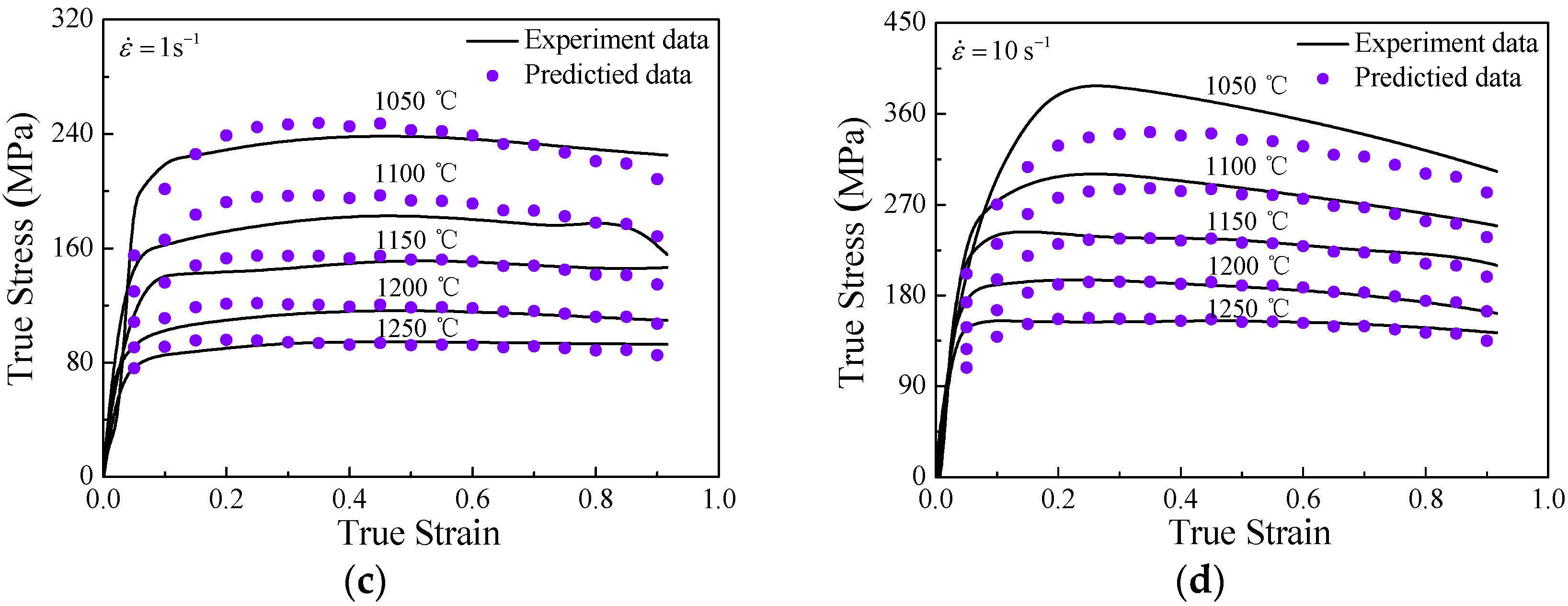
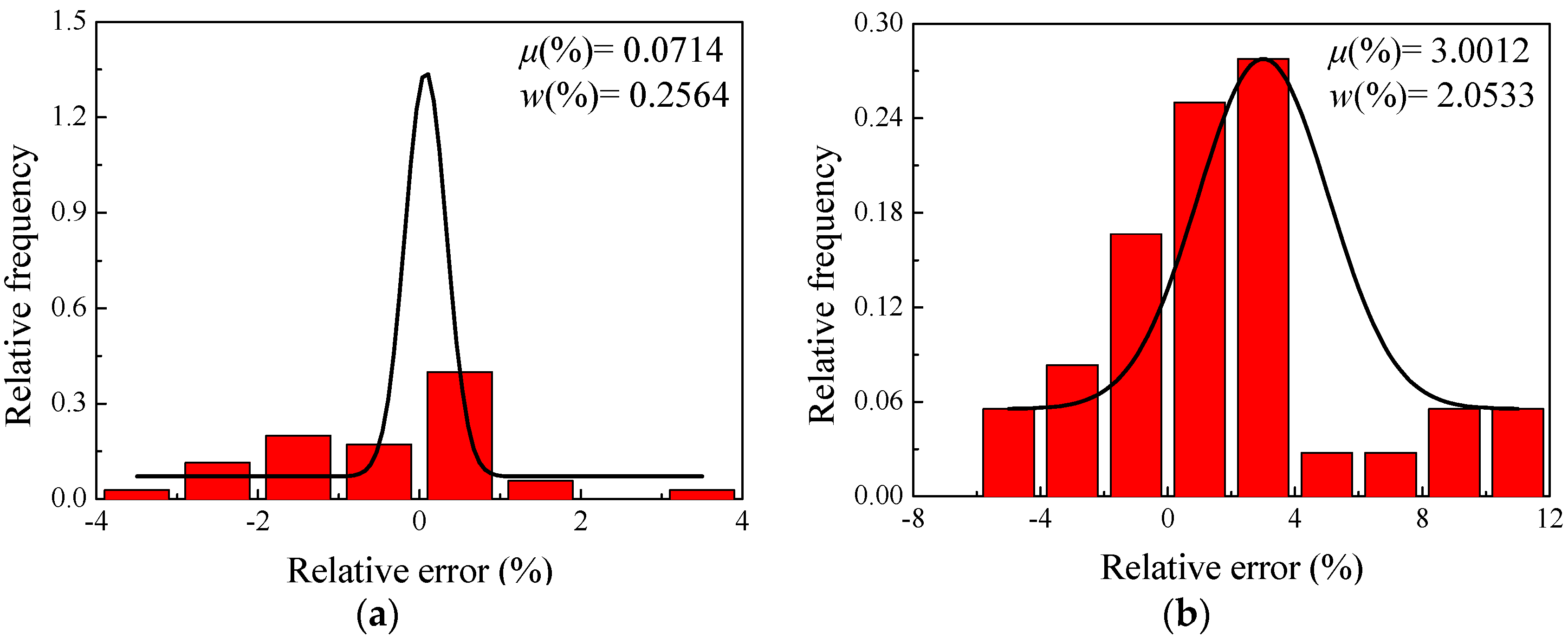
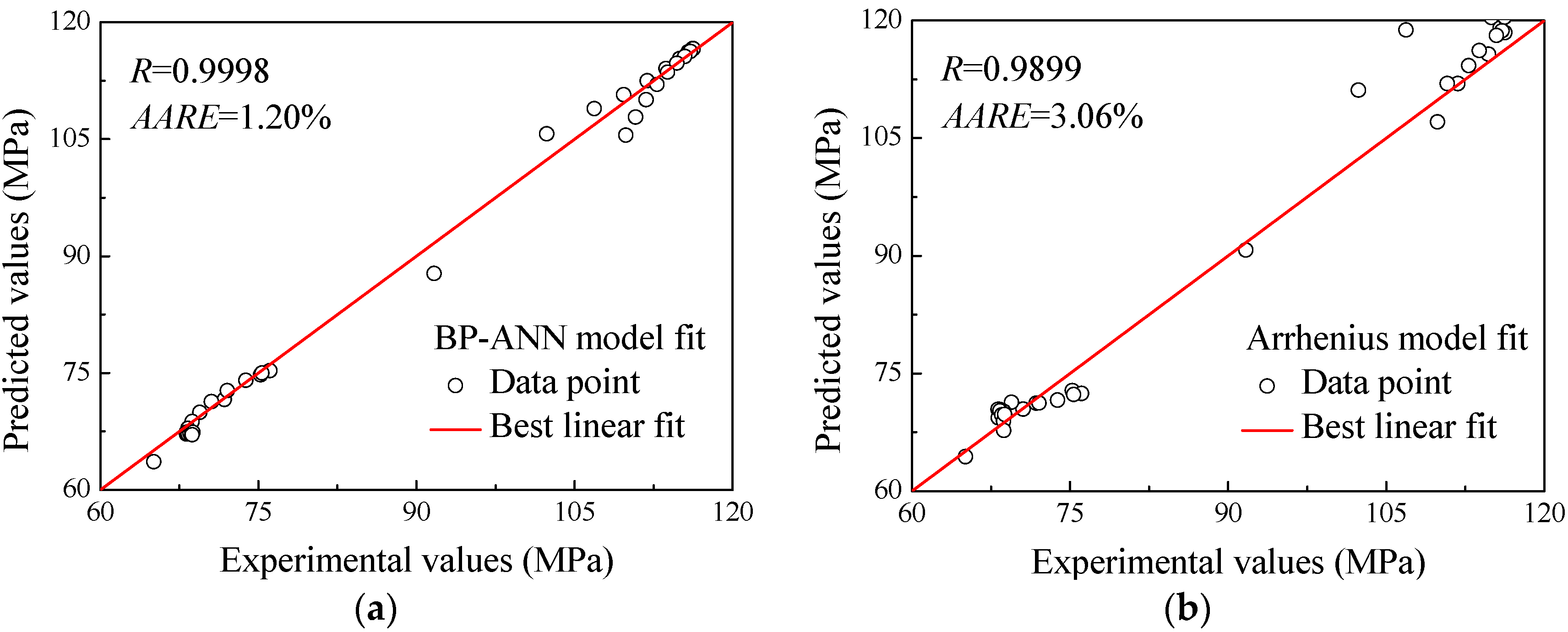
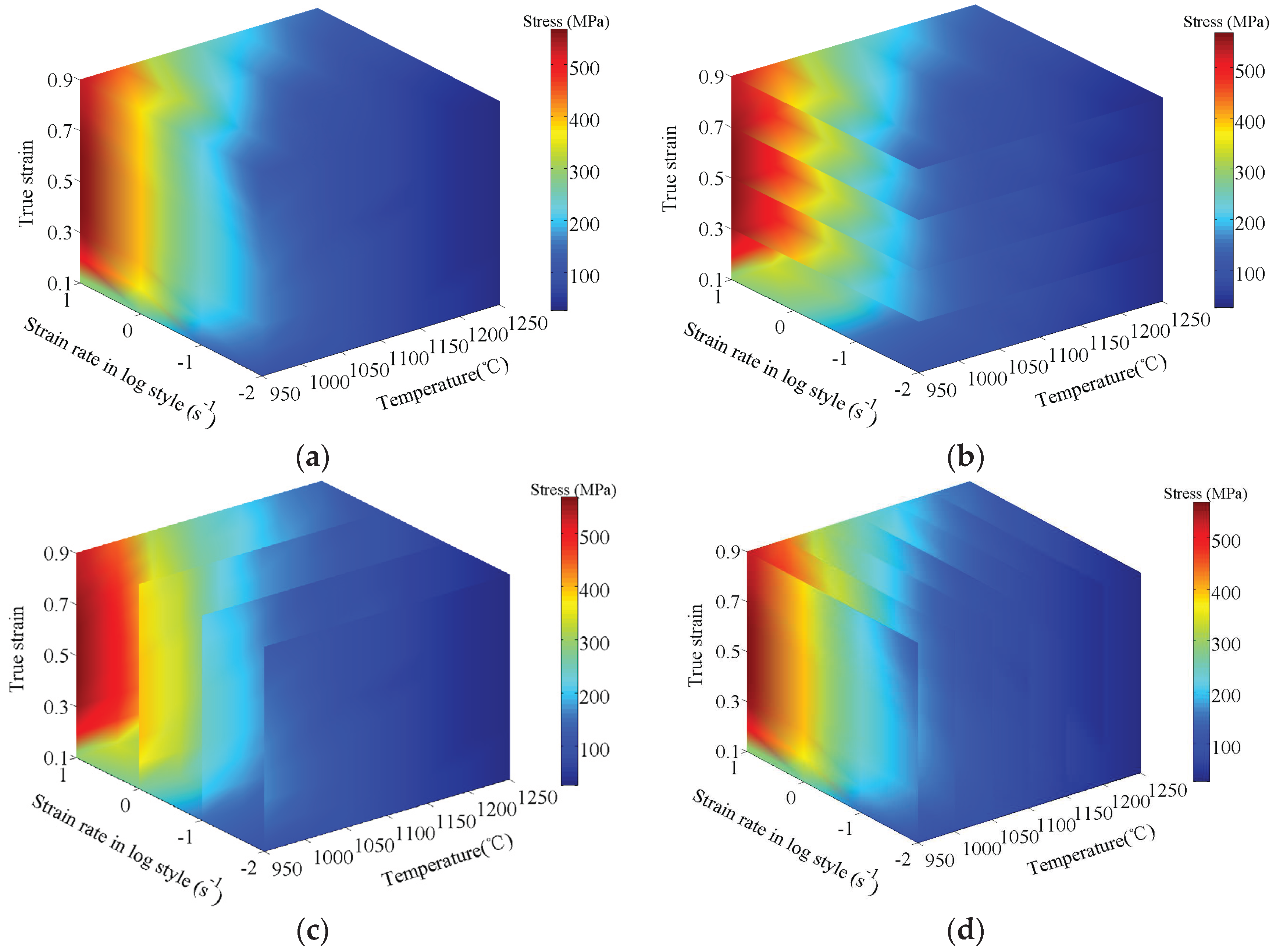
| α | lnA | n | Q | ||||
|---|---|---|---|---|---|---|---|
| B0 | 0.01006 | C0 | 40.29126 | D0 | 7.23447 | E0 | 467.28232 |
| B1 | −0.05783 | C1 | −144.12464 | D1 | −44.03632 | E1 | −1502.21622 |
| B2 | 0.33009 | C2 | 982.95072 | D2 | 234.75515 | E2 | 10438.62694 |
| B3 | −0.95142 | C3 | −3062.36904 | D3 | −653.05658 | E3 | −32768.83516 |
| B4 | 1.47519 | C4 | 4851.02761 | D4 | 984.16398 | E4 | 52125.14469 |
| B5 | −1.16554 | C5 | −3813.23640 | D5 | −756.88970 | E5 | −41.091.74522 |
| B6 | 0.36783 | C6 | 1183.77777 | D6 | 232.91924 | E6 | 12784.92195 |
| Strain Rate (s−1) | Temperature (°C) | Strain | True Stress (MPa) | Equation | Relative Error (%) | ||
|---|---|---|---|---|---|---|---|
| Experimental | BP-ANN | BP-ANN | Equation | ||||
| 0.01 | 1100 | 0.05 | 65.08 | 63.59 | 64.37 | −2.29 | −1.08 |
| 0.10 | 71.80 | 71.58 | 71.18 | −0.31 | −0.86 | ||
| 0.15 | 75.24 | 74.75 | 72.79 | −0.64 | −3.25 | ||
| 0.20 | 76.09 | 75.31 | 72.42 | −1.03 | −4.83 | ||
| 0.25 | 75.35 | 74.99 | 72.30 | −0.47 | −4.04 | ||
| 0.30 | 73.81 | 74.05 | 71.59 | 0.33 | −3.01 | ||
| 0.35 | 72.06 | 72.75 | 71.23 | 0.96 | −1.15 | ||
| 0.40 | 70.57 | 71.31 | 70.43 | 1.04 | −0.20 | ||
| 0.45 | 69.47 | 69.93 | 71.33 | 0.67 | 2.68 | ||
| 0.50 | 68.73 | 68.77 | 70.15 | 0.05 | 2.06 | ||
| 0.55 | 68.32 | 67.90 | 70.40 | −0.62 | 3.04 | ||
| 0.60 | 68.17 | 67.36 | 70.40 | −1.18 | 3.28 | ||
| 0.65 | 68.20 | 67.13 | 69.34 | −1.56 | 1.68 | ||
| 0.70 | 68.34 | 67.13 | 70.24 | −1.78 | 2.77 | ||
| 0.75 | 68.54 | 67.26 | 69.70 | −1.87 | 1.69 | ||
| 0.80 | 68.72 | 67.39 | 68.91 | −1.93 | 0.28 | ||
| 0.85 | 68.80 | 67.37 | 69.76 | −2.08 | 1.39 | ||
| 0.90 | 68.73 | 67.08 | 67.71 | −2.41 | −1.49 | ||
| 1 | 1200 | 0.05 | 91.67 | 87.76 | 90.72 | −4.26 | −1.04 |
| 0.10 | 102.36 | 105.69 | 111.12 | 3.24 | 8.55 | ||
| 0.15 | 106.88 | 108.91 | 118.77 | 1.90 | 11.13 | ||
| 0.20 | 109.66 | 110.69 | 121.14 | 0.94 | 10.47 | ||
| 0.25 | 111.91 | 112.48 | 121.60 | 0.51 | 8.66 | ||
| 0.30 | 113.69 | 114.08 | 120.83 | 0.35 | 6.28 | ||
| 0.35 | 114.99 | 115.35 | 120.39 | 0.31 | 4.69 | ||
| 0.40 | 115.82 | 116.21 | 119.02 | 0.34 | 2.76 | ||
| 0.45 | 116.23 | 116.63 | 120.40 | 0.34 | 3.59 | ||
| 0.50 | 116.27 | 116.61 | 118.44 | 0.30 | 1.87 | ||
| 0.55 | 115.99 | 116.25 | 118.69 | 0.22 | 2.33 | ||
| 0.60 | 115.45 | 115.62 | 118.07 | 0.14 | 2.26 | ||
| 0.65 | 114.71 | 114.75 | 115.69 | 0.04 | 0.86 | ||
| 0.70 | 113.82 | 113.58 | 116.16 | −0.20 | 2.06 | ||
| 0.75 | 112.83 | 112.03 | 114.25 | −0.71 | 1.26 | ||
| 0.80 | 111.81 | 110.07 | 111.94 | −1.55 | 0.12 | ||
| 0.85 | 110.80 | 107.84 | 111.96 | −2.67 | 1.05 | ||
| 0.90 | 109.86 | 105.50 | 107.05 | −3.97 | −2.56 | ||
© 2016 by the authors; licensee MDPI, Basel, Switzerland. This article is an open access article distributed under the terms and conditions of the Creative Commons by Attribution (CC-BY) license (http://creativecommons.org/licenses/by/4.0/).
Share and Cite
Quan, G.-z.; Pan, J.; Wang, X. Prediction of the Hot Compressive Deformation Behavior for Superalloy Nimonic 80A by BP-ANN Model. Appl. Sci. 2016, 6, 66. https://doi.org/10.3390/app6030066
Quan G-z, Pan J, Wang X. Prediction of the Hot Compressive Deformation Behavior for Superalloy Nimonic 80A by BP-ANN Model. Applied Sciences. 2016; 6(3):66. https://doi.org/10.3390/app6030066
Chicago/Turabian StyleQuan, Guo-zheng, Jia Pan, and Xuan Wang. 2016. "Prediction of the Hot Compressive Deformation Behavior for Superalloy Nimonic 80A by BP-ANN Model" Applied Sciences 6, no. 3: 66. https://doi.org/10.3390/app6030066







